These are among the many beautiful native plants that grow in Top O’Topanga. Many of them grow wild. For more native plants that grow here, see Native Plant Gardens.
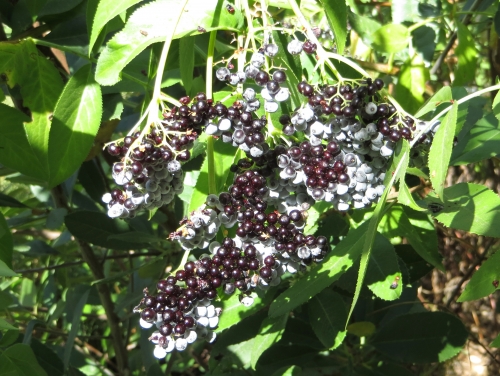 Blue Elderberry (Sambucus nigra ssp. caerulea)
Blue Elderberry (Sambucus nigra ssp. caerulea)
Shrub, tree; Full Shade, Part Shade, Full Sun
Grows 20-30 ft tall, 20-30 ft wide
Common uses: Bird Gardens, Butterfly Gardens, Bee Gardens
Blue Elderberry has cream or yellow flowers in the spring and purple berries in the fall. Its berries are one of the most important source of food for birds in California. It is tough, easy to grow, and grows rapidly. It can grow from a 1 gallon container to a 15 foot tree in 3 years if happy. It can handle permanently moist soil near stream sides or seeps, and will thrive next to or in regularly irrigated areas. Once established, it also grows well in fairly dry soils, though in drier conditions it will normally go deciduous or semi-deciduous in the summer and fall, and green up in the early winter. Drought-stressed Blue Elderberry’s often end up more attractive than ones that get plenty of year round water, frequently developing interesting gnarled branches and thicker though shorter trunks over time. It likes part shade or sun, and will tolerate full shade, though in full shade it will look rangy as its branches search out for more sun. Find out more on Calscape.
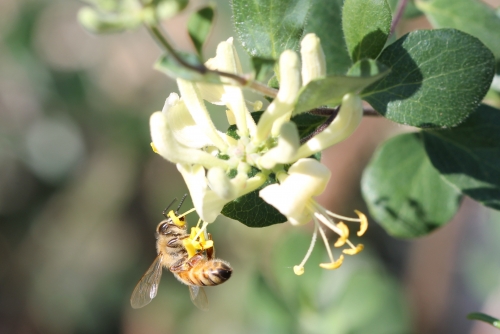 California Honeysuckle (Lonicera subspicata var. denudata)
California Honeysuckle (Lonicera subspicata var. denudata)
Vining shrub, part shade/full sun
Grows 8 ft tall, 20 ft wide
Common uses: Hedges, Hummingbird Gardens, Bird Gardens
Despite the common name, this fragrant vining shrub grows across much of southern and central California. It usually climbs on other plants for support, lined with oval leaves up to 4 centimeters long. The flower cluster is a long, fuzzy spike of light yellow flowers each about a centimeter long. The flower has an upper and lower lip with hairy stamens and style protruding. The fruit is a round red or yellow berry just under a centimeter wide. Find out more on Calscape.
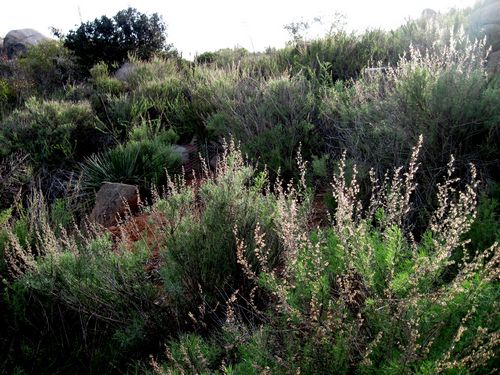 California Sagebrush (Artemisia californica)
California Sagebrush (Artemisia californica)
Shrub, full sun
Grows 1-8 ft tall, 4 ft wide
Common uses: Groundcovers, Butterfly Gardens, Bird Gardens
California sagebrush is a highly aromatic shrub that branches from the base and grows out from there, becoming rounded. This plant is extremely drought tolerant, and will often be the only plant growing on the driest, south-facing slopes in the driest parts of its range. It’s tough, and fast and easy to grow. It can handle occasional summer water, or no water at all during the summer. It can get weedy, but its foliage is a beautiful silvery color when backlit by the sun. This is one of the foundation plants of the coastal sage scrub community and the preferred plant of the California gnatcatcher, a threatened species. It is a natural “herbicide.” Find out more on Calscape.
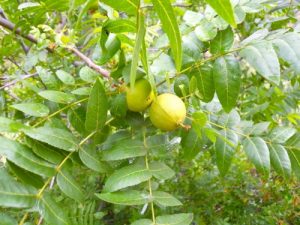 California Walnut (Juglens californica)
California Walnut (Juglens californica)
Tree, full sun or part shade
Grows 50-75 ft tall, 50-75 ft wide
Common uses: Bird gardens, Butterfly Gardens
This is a great choice for wildlife gardens and especially for attracting birds, which eat the nuts and like to nest in the branches. Unfortunately, it is now endangered in large parts of the southern portion of its natural range due to continued development. Hopefully native gardeners in southern California will help restore this important part of the ecosystem. Best to plant near an irrigated area, or naturally moister areas such as a stream bed, seep or canyon bottom. Toxins in walnut seeds will typically prevent other plants from growing under this tree, so don’t try to put understory plants too near this tree. It has a small hard nut in a shallowly grooved thick shell that is difficult to remove. The Chumash Indians of the Channel Islands of California eat the nuts, however, they are not grown commercially for this purpose. Find out more on Calscape.
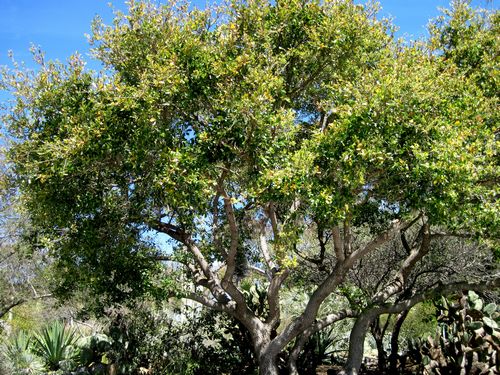 Coast Live Oak (Quercus agrifolia)
Coast Live Oak (Quercus agrifolia)
Tree, full sun or part shade
Grows 25-82 ft tall, 15-35 ft wide
Common uses: Bank Stabilization, Hedges, Bird Gardens, Butterfly Gardens
The Coast Live Oak is a beautiful, easy-to-grow evergreen that sometimes s attain an age exceeding 250 years, with trunk diameters up to three or four meters. Younger trees are often shrubby. The leaves are dark green with sharp thistly fibers that extend from the lateral leaf veins, designed for maximum solar absorption. Flowers are produced in early-to-mid spring. The fruit is a slender reddish brown acorn that attracts a variety of birds and butterflies. Water once per week the first year after planting, decreasing to about once per month after the first year, until the tree is about 10 feet tall. After that, it’s best to avoid direct summer water entirely. In areas with less rainfall, best to plant Coast Live Oaks near an irrigated area. They prefer to have their roots shaded, so it’s a good idea to surround young specimens with mulch, rocks, or smaller native plants that won’t crowd out the young tree trees but will provide shade to the roots. The best mulch is a thick layer of oak leaves. Don’t fertilize oaks. They’ll amend the soil over time with their own leaves and build the natural mycorrhizal fungus in the soil they need to thrive. Gradually, they become islands of natural fertility that improve the health of the nearby plants. Find out more on Calscape.
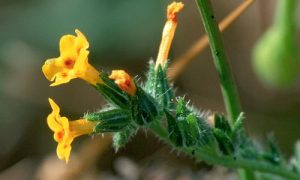 Fiddleneck (Amsinckia intermedia)
Fiddleneck (Amsinckia intermedia)
Annual herb, full sun
Grows 0.7 – 3.9 ft tall
Common uses: Butterfly Gardens
Like other members of the genus, it has a terminal flowering whorl somewhat shaped like the head of a violin or fiddle, hence the name fiddleneck. The flowers are yellow-orange, orange, or dark yellow. Find out more on Calscape.
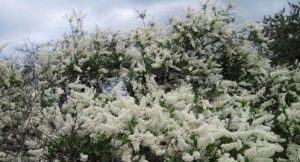
Greenbark Ceonothus (Ceanothus spinosus)
Shrub, full sun
Grows 10-20 ft tall, 10 ft wide
Common uses: Bank Stabilization, Bird Gardens, Butterfly Gardens, Bee Gardens
This is a large treelike shrub. The stem is a rough-barked trunk near the base and has thorny, greenish-brown branches. The thick, firm evergreen leaves are up to 4 or 5 centimeters long and are hairless on the upper surface but sometimes lined with hairs underneath. The shrub blooms in flower clusters up to 15 centimeters long filled with clusters of white to pale blue flowers. The flowers are a natural hand cleanser. The fruit is a smooth, round capsule about half a centimeter wide containing three seeds. Find out more on Calscape.
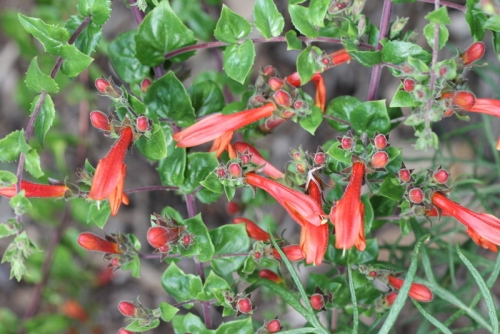 Heart Leaved Penstemon (Keckiella cordifolia)
Heart Leaved Penstemon (Keckiella cordifolia)
Shrub, Part Shade, Full Sun
Grows 3-6.6 ft tall, 3-6 ft wide
Common uses: Hummingbird Gardens, Bird Gardens, Butterfly Gardens, Bee Gardens
This is a spreading shrub with shiny green heart-shaped leaves and hairy flower clusters of many flowers each. The flower is somewhat tubular with a wide open mouth. It is fuzzy on the external surface and any shade of pale orange to deep scarlet. Best to place this plant in shady slopes in hotter inland areas, preferably in places with a little more natural groundwater such as slope bottoms. Place in sunny spots in cooler coastal areas. Find out more on Calscape.
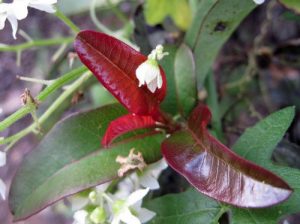
Laurel Sumac (Malosma laurina)
Shrub, full sun
Grows 10-20 ft wide, 20 ft wide
Common uses: Bank Stabilization, Hedges, Bird Gardens, Butterfly Gardens
Laurel Sumac is a member of the Anacardaceae (Cashew) family and a key member of coastal sage scrub and chaparral ecosystems. In bloom, it is intensely aromatic. The lance-shaped leaf blades are up to 10 centimeters long, with reddish veins and stems. The very small flowers have five white petals and five-lobed green sepals. Large clusters of these flowers occur at the ends of twigs in late spring and early summer. The clusters are 7-15 centimeters long, and are reminiscent of lilac. The fruit is whitish with a smooth, flattish stone inside. This plant is very drought tolerant but not cold tolerant and is not found in areas where freezing temperatures are normal. This plant is a necessity for the southern California chaparral garden, and it is great for birds and wildlife. Find out more on Calscape.
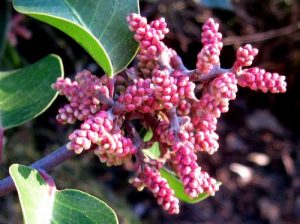
Sugarbush (Rhus ovata)
Shrub, full sun or part shade
Grows 6.6-32.8 ft tall, 30 ft wide
Common uses: Bank Stabilization, Hedges, Bird Gardens, Butterfly Gardens
Also known as Sugar Sumac, the twigs are thick and reddish in color, its foliage consists of dark green, leathery leaves. Its flower clusters which occur at the ends of branches consist of small, 5-petaled, flowers that appear to be pink, but upon closer examination actually have white to pink petals with red sepals. The fruit is a small reddish, sticky drupe, about 6 – 8 millimeter in diameter that is said to be edible. Tough and easy to grow, and very fast growing once established. A 5 gallon container plant will reach 10 feet in about 3 years if happy. In nature, you’ll almost always see Sugar Bush on slopes, though it grows well on flat areas in garden applications. It’s one of the few larger chaparral shrubs that grows well in south facing slopes even in the drier parts of it’s range, and is a great bank stabilizer. It tolerates a wide variety of soils. It grows fastest with full sun, and just a little slower in part shade. It tolerates summer water up to 1x per month, but shouldn’t need any once established. The plants are incredibly healthy, and typically will appear green and lush through the entire dry season without any supplementary water. The biggest downside of this plant is that it can get huge, often more than 30 feet wide, and can aggressively crowd out nearby plants. Find out more on Calscape.
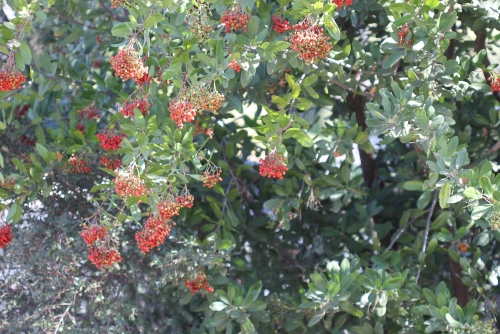 Toyon (Heteromeles arbutifolia)
Toyon (Heteromeles arbutifolia)
Shrub, Full sun or part shade
Grows 6-30 ft tall, 10-15 ft wide
Common uses: Bank Stabilization, Hedges, Bird Gardens, Butterfly Gardens
Toyon is a beautiful, easy-to-grow perennial shrub known by the common names Christmas berry and California Holly from the bright red berries it produces. The city of Hollywood was named for this plant. Its leaves are evergreen. In the early summer it produces small white flowers in dense bunches that are visited by butterflies and other insects. The berries are consumed by birds, including mockingbirds, American robins, and cedar waxwings. Mammals including coyotes and bears also eat and disperse the berries. They need more moisture than most chaparral shrubs and do well near seasonal creeks, seeps, bottom of slopes, or near irrigated areas. These plants tolerate a fair amount of summer water, up to 1x per week if the drainage is good. They are an excellent hedge plant. Find out more on Calscape.
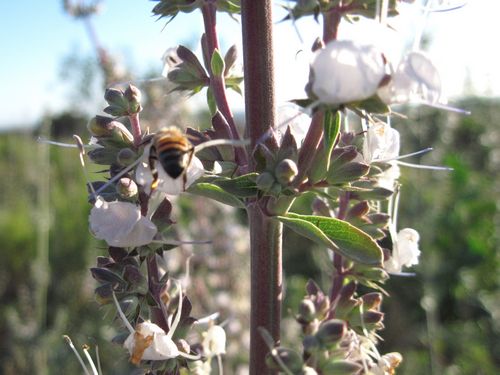
Shrub, full sun
Grows 3-5 ft tall, 3-8 ft wide
Common uses: Bank Stabilization, Groundcovers, Hedges, Hummingbird Gardens, Bird Gardens, Butterfly Gardens, Bee Gardens
White sage, bee sage, or sacred sage, is one of the cornerstone species of the coastal sage scrub habitat of Southern California. It grows rapidly to 3 or 4 feet tall, with white flower spikes shooting up sometimes 8 feet or more. The leaves are covered with dense hairs, which give them a white coloring, sometimes with a blueish tint. Younger leaves tend to be greener, and turn whiter as they get older. Each flower spikes bears ~100 white flowers with tiny lavender spots and streaks. From a few feet away, the white flowers sometimes appear to have a purplish tint. White sage is strongly aromatic, with a powerful and slightly acrid sage smell. Native people use the dried leaves as an incense for ceremonial purposes (e.g. smudge sticks). Var. apiana is more common but var. compacta may be superior for the garden due to its less sprawling habit. Either will attract a variety of birds and insects. Find out more on Calscape.
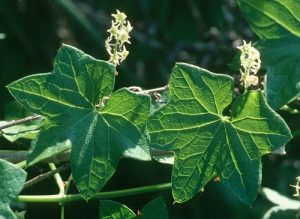 Wild Cucumber (Marah macrocarpa)
Wild Cucumber (Marah macrocarpa)
Vine/Perennial herb, Full sun
Can grow 20 ft
Common uses: Butterfly Gardens
This vine has coiling tendrils that enable them to climb up other plants; they can also grow rapidly across level ground. The fruits are poisonous, large, and covered in long spines. The Chumash made necklaces from the seeds. Find out more on Calscape and Wikipedia.
Non-Native, Non-invasive Plants
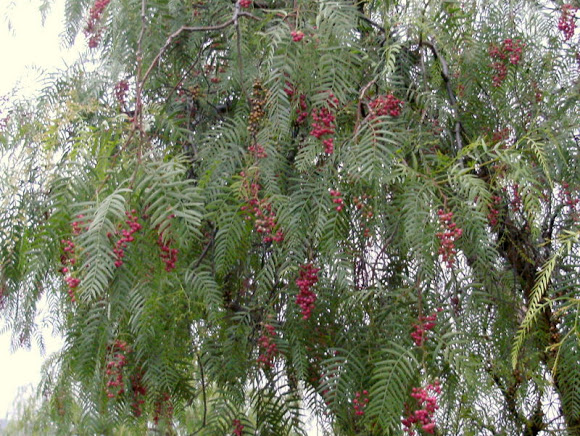 California Pepper (Schinus molle)
California Pepper (Schinus molle)Tree, full sun
Grows up to 40 ft tall, 40 ft wide
This is a fast-growing, non-native evergreen shade tree. It often grows branches as wide as wide as the tree is tall. California pepper trees look lacy because of the compound, pinnate leaves, each one composed of fine-textured leaflets. The leaves are aromatic. Greenish-white flowers appear at the ends of the branches in spring, evolving by autumn into rosy berries. When these evergreens are young, their trunks are gray. As the trees mature, their bark peels back revealing the red inner wood. Find out more at Gardening Know How.
Non-Native Invasive Plants
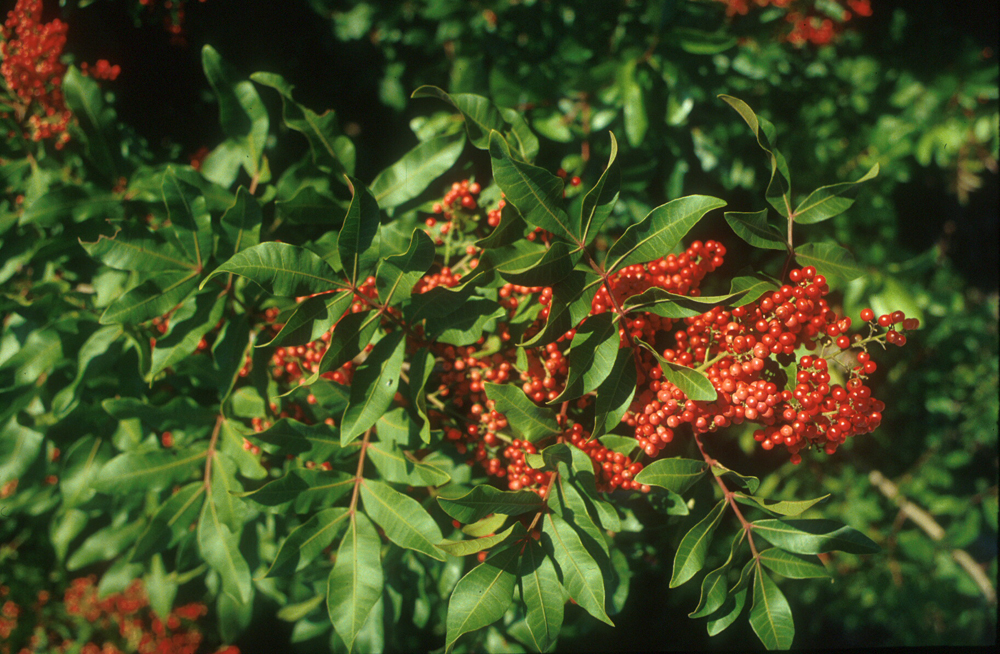 Brazilian Pepper (Schinus terebinthifolius)
Brazilian Pepper (Schinus terebinthifolius)
This is an evergreen shrub or small tree that out-compete and displace native plants. They can quickly grow to dominate and eliminate native plant species upon which animals rely for food and shelter. They are difficult to completely eradicate. Its pink fruits are sold as peppercorns, but they may be toxic to humans and animals if too many are eaten. In order to control peppertree infestations, tree roots must be removed or killed, and seedlings must be controlled by hand-pulling for at least three years.
Horehound (Marrubium vulgare)
Perennial herb, Part-sun
Grows 10-18 in tall
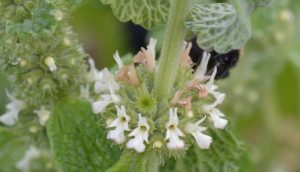 This flowering herb has been used medicinally dating at least back to the 1st century BC, where it appears as a remedy for respiratory ailments. It is packed with nutritional benefits including high amounts of Vitamins A, B, C, and E. The leaves can be dried and used to make tea and the leaves can be stored for up to a year in a jar. The oil can be expressed and used in perfumes and potpourri. The strong flavor has been compared to menthol and root beer, and is used in cough drops, candy, liqueurs, beer, and the rock and rye cocktail. Stems can be steeped for tea or as a tincture. For more information, see Gardening Know How or Wikipedia.
This flowering herb has been used medicinally dating at least back to the 1st century BC, where it appears as a remedy for respiratory ailments. It is packed with nutritional benefits including high amounts of Vitamins A, B, C, and E. The leaves can be dried and used to make tea and the leaves can be stored for up to a year in a jar. The oil can be expressed and used in perfumes and potpourri. The strong flavor has been compared to menthol and root beer, and is used in cough drops, candy, liqueurs, beer, and the rock and rye cocktail. Stems can be steeped for tea or as a tincture. For more information, see Gardening Know How or Wikipedia.